Along with many other anglers, at this time of year I’m always keen to step onto my local rock ledges and pelt lures for the run of pelagic fish.
Although there were a few seasons when other pursuits kept me away from the rocks, I first started spinning back in the mid to late 1980s from the famous South Avoca platform. Immediately impressed with this style of fishing, I soon purchased the best gear available at the time and spread my efforts around to a number of other Central Coast rock spots.
Unlike quite a few other rockhoppers back then, I never really spent much time live-baiting for bigger fish. I was having too much fun hooking into all those bonito, rat kings, frigates and whatever else came along.
Part of the reason I still enjoy spinning from the rocks is that today’s tackle is so much lighter and more advanced than what was commonly used 20 years ago.
Overhead reels used to be the main tools used for rock spinning back in the early days and many anglers still prefer them. Most mid-sized overhead reels hold a lot of line, which can be advantageous if bigger tuna are around. And there’s virtually no chance of line twist problems with overheads.
However, the inevitable bird’s nest or backlash is something that even proficient casters experience from time to time.
Thankfully, a number of modern overheads that have been designed with casting in mind are fitted with quite effective anti-backlash mechanisms. These don’t eliminate the problem but they do reduce the chances of it happening.
Some good casting overheads include the Daiwa 7HT and SL30SHB, Shimano Torium 20 and ABU 6500. Generally, though, reels with fast gears are the preferred weapons, which will help you retrieve the lures quicker and hook more fish.
It’s probably a good idea to spool up with nylon mono rather than braid, unless you’re quite confident with your casting abilities. A lot of dedicated rock anglers load two-thirds of their spool with braid and top up with mono. This way it’s possible to increase your overall line capacity by an extra 20% or more.
Although I first started casting with overheads, I soon became an eggbeater man. I used an old Mitchell 499 for quite a few years; it was as tough as nails and as heavy as a brick.
Then I switched over to the lighter Shimano Speedmaster threadlines, which weren’t as rugged as the big Mitchell but were more suited to the task. A lot of anglers also favoured the American Penn Spinfishers.
I also tried a number of other high-speed threadlines over the years and must admit that most of them simply couldn’t hack the pace. However, my current high-speed threadline is a Daiwa Ballistic 4000, which is so much lighter and nicer to use than all those old reels and does the job perfectly.
I upgraded the drag with Carbontex washers with a light coating of Cal’s Lube and the drag is now very smooth and powerful.
Anything from 6kg-10kg braid or mono can be used for high-speed spinning but some may prefer 3kg-4kg on a lighter outfit to increase the fun factor. Of course, if kings are your primary target, then you may want to step up to heavier line.
A fine diameter braid works well with most threadlines but it’s important to have a suitable leader.
In most cases a nylon mono leader is best and should be around the same length as the rod. Most of the time I use 25lb mono, which gives me confidence when lifting fish onto the rocks.
Rods for overheads or threadlines should be around 3m long and reasonably well made. This isn’t the type of fishing where you can skimp out with el cheapo tackle and expect good results.
There are quite a few good rods around these days but some may prefer to get a rod custom.
Apart from being strong, it’s important that it has a whippy tip that can really pelt out lures. Before buying a spinning rod, be sure to check that it’s suitably matched to the lure weights you’ll be casting, in most cases 30g-50g.
It can also be a good idea to bring two outfits along, either a back-up spinning outfit in case of gear failure or a different type of outfit for other fish. If the pelagics don’t show up then a few bream or blackfish may save the day.
Stacks of lures can be used for this type of fishing but it’s hard to go past simple metal lures. At the top of the list is the 40g SureCatch Knight. They are the perfect all-round lure for any you’re likely to encounter and the 20g and 65g models may also be worth having in the box. Others like Raiders, Lazers and chrome Halcos are worth investing in.
Most anglers get a buzz out of casting surface poppers and they can be quite effective, particularly for tailor and kingfish. Floating poppers can be cast over shallow reefs, where sinking metals are likely to get snagged. A couple of good ones worth trying are Halco Roosta poppers and the cheaper but versatile Trollcraft poppers.
Surface stickbaits are another alternative and I’ve enjoyed success with the Maria Miss Carna. The 110mm has been particularly effective for salmon, bonito and tailor.
Swimming hardbodies also catch fish but there aren’t a lot of really good ones on the market suited to rock spinning, mainly due to their poor casting ability. The Maria Duplex and Rapala X-Rap Saltwater have proven track records and weigh enough to cast about 40m.
From about Port Stephens down to the Far South Coast bonito are the primary targets. They are particularly popular on the Central Coast and off Sydney’s rocks from late December to about the end of May.
They’re more likely to be found off deepwater ledges or prominent headlands but occasionally move into shallow bays and Sydney Harbour.
Whitewash isn’t overly important when spinning for bonito, although a bit of wash around the rocks is generally better than none. They can show up in dirty green water, but you’re more likely to do better when the water looks blue and is over 21°.
A fast retrieve is the key to catching bonito, although there’s no point winding so fast that the lure is simply skimming across the top. If the bottom isn’t too snaggy, the best idea is to cast out and allow the lure to sink a bit before starting the retrieve.
Go as fast as you can and mix things up with a few stops, starts and rod twitches. Each day is different and bonito can be tricky fish at times, but a really fast retrieve is normally best.
Kingfish are probably the second most common fish you’ll hook in Summer. They’re also more highly prized because they fight so hard and most believe that they’re better on the plate.
Even relatively small kings can dive towards reef or under ledges so it may pay to crank up your drag and double check all knots, split rings and hooks. Most kings along the rocks are just 2kg-3kg rats and can generally be handled without drama but much bigger fish are always possible.
Kings respond well to chrome lures retrieved flat out but they’re also very fond of white lures. Some days they’ll freely hit poppers, while other days they’ll refuse almost anything you throw.
When all else fails, big white soft plastics can bring them undone. These can be retrieved fast or more slowly with plenty of rod movement.
Four other reasonably common pelagics are the Watson’s leaping bonito, mack tuna, striped tuna and frigate mackerel. All are similar in habits to the common bonito but they vary in size and geographical range.
The Watson’s leaping bonito rarely grows bigger than a kilo and is much more common north of Forster. Every 10 years or so they seem to show up in reasonable numbers around Sydney and further south.
In recent years mack tuna have shown up in big numbers right along the NSW coast during late Summer and Autumn, although very few caught south of Port Macquarie have exceeded 3kg.
Striped tuna were much more common a few decades ago but their numbers fell dramatically, probably due to excessive commercial pressure. They seem to have bounced back in recent years, although they’re still comparatively uncommon.
The small frigate mackerel show up in April and May and can venture well up estuaries, although they are more likely in sheltered bays. I’ve found the 20g SureCatch Knight reliable for them.
Tailor and salmon often get in on the act, regardless of time of year. Like them or not, a bit of variety can only add to the overall enjoyment of spinning from the rocks.
Facts
THINK SAFE, STAY ALIVE
Every time you fish off the rocks you take your life into your own hands.
• Always check the weather
• Check for safety alerts
• Choose a safe spot
• Don't fish alone
• Wear non-slip shoes
• Wear a lifejacket
• Never turn your back on the sea
• If you’re not sure, go somewhere safer

Bonito are more commonly encountered during late Summer and early Autumn from rocks that front reasonably deep water. Lure speed is a real key to catching them.
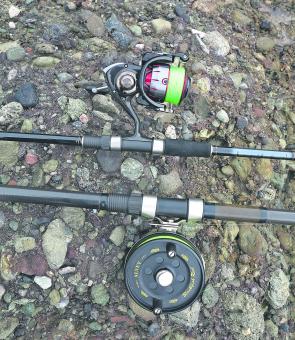
It’s not a bad idea when spinning from the rocks to bring along a second outfit. If the pelagics don’t show up then bream or blackfish may save the day.
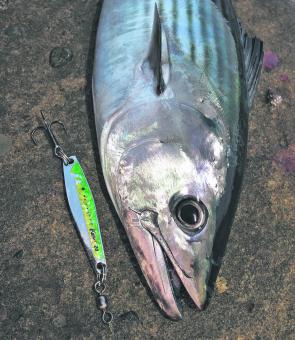
The SureCatch Knight is one of the most reliable lures for high-speed spinning, although there are quite a few other similar lures on the market.
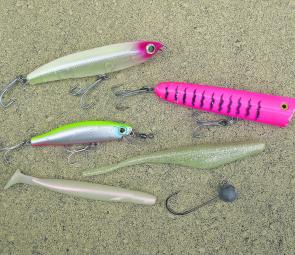
Surface lures, diving hardbodies and soft plastics all have their places when it comes to rock spinning.
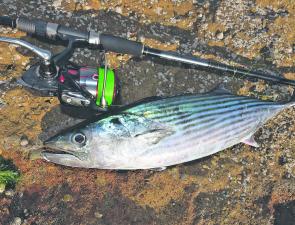
Quality high-speed reels are essential equipment when it comes to spinning through Summer and Autumn.

Tailor can be voracious feeders on the ocean rocks, especially in Autumn.
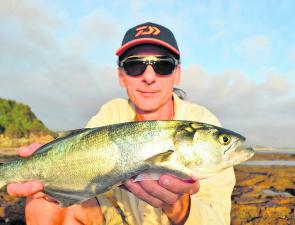
Tailor of this size can smash a lure hard and perform beautifully in the smoker.




